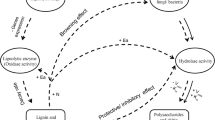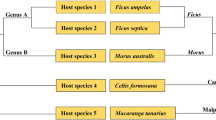Abstract
Decomposition processes of Camellia japonica leaf litter were investigated over an 18-month period with reference to the role of fungal succession in the decomposition of lignin and holocellulose. Decomposition and fungal succession were studied in bleached and nonbleached portions of litter, which were precolonized by ligninolytic and cellulolytic fungi, respectively. Coccomyces nipponicum and Lophodermium sp. (Rhytismataceae), which can attack lignin selectively, caused mass loss of lignin and were responsible for bleaching during the first 4 months (stage I), whereas cellulolytic fungi caused mass loss of holocellulose in adjacent nonbleached portions. Soluble carbohydrates and polyphenols also decreased rapidly during this stage. Pestalotiopsis guepini, coelomycete sp.1, and the Nigrospora state of Khuskia oryzae caused mass loss of holocellulose between 4 and 14 months (stage II) and Xylaria sp. caused mass loss of both lignin and holocellulose from 14–18 months (stage III). In stages II and III, decomposition was more rapid in bleached portions than in nonbleached portions probably due to the prior delignification of lignified holocellulose in bleached portions. Frequencies of these fungi showed different responses among species to the pattern of changes in lignin and holocellulose contents during decomposition. Total hyphal length increased in both portions over the study period, but mycelia of basidiomycetes accounted for about 2% of total hyphal length, suggesting that their role in fungal succession and decomposition was low. Lignin and nitrogen contents were consistently lower and holocellulose content was higher in bleached portions than in nonbleached portions during decomposition. The succession of ligninolytic and cellulolytic fungi was a major driving factor that promoted decomposition and precolonization by ligninolytic fungi enhanced decomposition.





Similar content being viewed by others
References
Aber JD, Mellilo JM, McClaugherty CA (1990) Predicting long-term patterns of mass loss, N dynamics, and soil organic matter formation from initial fine litter chemistry in temperate forest ecosystems. Can J Bot 68:2201–2208
Berg B (1991) FDA-active fungal mycelium and lignin concentrations in some needle and leaf litter types. Scand J For Res 6:451–462
Berg B, McClaugherty C (2003) Plant litter, decomposition, humus formation, carbon sequestration. Springer-Verlag, Berlin Heidelberg New York
Berg B, Söderström B (1979) Fungal biomass and nitrogen in decomposing Scots pine needle litter. Soil Biol Biochem 11:339–341
Berg B, Hannus K, Popoff T, Theander O (1982) Changes in organic chemical components of needle litter during decomposition Long-term decomposition in a Scots pine forest I. Can J Bot 60:1310–1319
Berg B, McClaugherty C, Johansson MB (1997) Chemical changes in decomposing litter can be systemized with respect to the initial chemical composition of the litter. Swedish University of Agricultural Sciences Report 74, Uppsala
Cabral D (1985) Phyllosphere of Eucalyptus viminalis: dynamics of fungal populations. Trans Br Mycol Soc 85:501–511
Cooke RC, Rayner ADM (1984) Ecology of saprotrophic fungi. Longman, London
Cooke RC, Whipps JM (1993) Ecophysiology of fungi. Blackwell Scientific, Oxford
Dubois M, Gilles KA, Hamilton JK, Rebers PA, Smith F (1956) Colorimetric method for determination of sugars and related substances. Anal Chem 28:350–356
Fioretto A, Musacchio A, Andolfi G, Virzo de Santo A (1998) Decomposition dynamics of litters of various pine species in a Corsican pine forest. Soil Biol Biochem 30:721–727
Godeas AM (1987) Decomposition studies on Pinus taeda forests. II. Decomposition of leaf litter. Pedobiologia 30:323–331
Harris GCM (1945) Chemical changes in beech litter due to infection by Marasmius peronatus (Bolt). Fr Ann Appl Biol 32:38–39
Hasegawa M, Takeda H (1996) Carbon and nutrient dynamics in decomposing pine needle litter in relation to fungal and faunal abundances. Pedobiologia 40:171–184
Hering TF (1967) Fungal decomposition of oak leaf litter. Trans Br Mycol Soc 50:267–273
Hintikka V (1970) Studies on white-rot humus formed by higher fungi in forest soils. Comm Inst For Fenn 69:1–68
Hudson HJ (1968) The ecology of fungi on plant remains above the soil. N Phytol 67:837–874
Jones PCT, Mollison JE (1948) A technique for the quantitative estimation of soil microorganisms. J Gen Microbiol 2:54–69
King HGC, Heath GW (1967) The chemical analysis of small samples of leaf material and the relationship between the disappearance and composition of leaves. Pedobiologia 7:192–197
Kinkel LL, Andrews JH (1988) Disinfestation of living leaves by hydrogen peroxide. Trans Br Mycol Soc 91:523–528
Kirk TK, Connors WJ, Zeikus G (1976) Requirement for a growth substrate during lignin decomposition by two wood-rotting fungi. Appl Env Microbiol 32:192–194
Kjøller A, Struwe S (1982) Microfungi in ecosystems: fungal occurrence and activity in litter and soil. Oikos 39:389–422
Koide K, Osono T (2003) Chemical composition and mycobiota of bleached portion of Camellia japonica leaf litter at two stands with the different nitrogen status. J Jpn For Soc 85:359–363
Kuyper TW, Bokeloh DJ (1994) Ligninolysis and nitrification in vitro by a nitrotolerant and a nitrophobic decomposer basidiomycetes. Oikos 70:417–420
Lindeberg G (1946) On the decomposition of lignin and cellulose in litter caused by soil-inhabiting Hymenomycetes. Ark Bot 33a:1–16
Mikola P (1956) Studies on the decomposition of forest litter by basidiomycetes. Commun Inst For Fenn 48:4–48
Miyamoto T, Igarashi T, Takahashi K (2000) Lignin-degrading ability of litter-decomposing basidiomycetes from Picea forests of Hokkaido. Mycoscience 41:105–110
Olson FCW (1950) Quantitative estimates of filamentous algae. Trans Am Microsc Soc 69:272–279
Olson J (1963) Energy storage and the balance of producers and decomposers in ecological systems. Ecology 44:322–331
Osono T (2002) Phyllosphere fungi on leaf litter of Fagus crenata: occurrence, colonization, and succession. Can J Bot 80:460–469
Osono T, Takeda H (1998) Fragmentation process of leaf litter in Mull-type organic soil. J Jpn For Soc 80:196–200
Osono T, Takeda H (2001a) Effects of organic chemical quality and mineral nitrogen addition on lignin and holocellulose decomposition of beech leaf litter by Xylaria sp. Eur J Soil Biol 37:17–23
Osono T, Takeda H (2001b) Organic chemical and nutrient dynamics in decomposing beech leaf litter in relation to fungal ingrowth and succession during three year decomposition processes in a cool temperate deciduous forest in Japan. Ecol Res 16:649–670
Osono T, Takeda H (2002) Comparison of litter decomposing ability among diverse fungi in a cool temperate deciduous forest in Japan. Mycologia 94:421–427
Osono T, Takeda H (2004) Accumulation and release of nitrogen and phosphorus in relation to lignin decomposition in leaf litter of 14 tree species in a cool temperate forest. Ecol Res 19:593–602
Osono T, Takeda H (2005) Decomposition of lignin, holocellulose, polyphenol and soluble carbohydrate in leaf litter of 14 tree species in a cool temperate forest. Ecol Res 20:41–49
Osono T, Fukasawa Y, Takeda H (2003a) Roles of diverse fungi in larch needle-litter decomposition. Mycologia 95:820–826
Osono T, Ono Y, Takeda H (2003b) Fungal ingrowth on forest floor and decomposing needle litter of Chamaecyparis obtusa in relation to resource availability and moisture condition. Soil Biol Biochem 35:1423–1431
Osono T, Bhatta BK, Takeda H (2004) Phyllosphere fungi on living and decomposing leaves of giant dogwood. Mycoscience 45:35–41
Reid ID, Deschamps AM (1991) Nutritional regulation of synthetic lignin (DHP) degradation by the selective white-rot fungus Phlebia (Merulius) tremellosa: effects of glucose and other cosubstrates. Can J Bot 69:147–155
Saito T (1957) Chemical changes in beech litter under microbiological decomposition. Ecol Rev 14:209–216
Saito T (1960) An approach to the mechanism of microbial decomposition of beech litter. Sci Rep Tohoku Univ Ser IV (Biol) 25:125–131
Sokal RR, Rohlf FJ (1995) Biometry 3rd. WH Freeman, New York
Swift MJ, Heal OW, Anderson JM (1979) Decomposition in terrestrial ecosystems Studies in ecology, vol 7. Blackwell Scientific, Oxford
Tanaka H, Enoki A, Fuse G, Nishimoto K (1988) Interactions in successive exposure of wood to varying wood-inhabiting fungi. Holzforschung 42:29–35
Usher M (1970) Seasonal and vertical distribution of a population of soil arthropods: Collembola. Pedobiologia 10:224–236
Waterman PG, Mole S (1994) Analysis of phenolic plant metabolites. Blackwell Scientific, Oxford
West AW (1988) Specimen preparation, stain type, and extraction and observation procedures as factors in the estimation of soil mycelial lengths and volumes by light microscopy. Biol Fertil Soils 7:88–94
Widden P, Parkinson D (1973) Fungi from Canadian coniferous forest soils. Can J Bot 51:2275–2290
Acknowledgements
We thank Dr. S. Tokumasu, Dr. S. Iwamoto, and Dr. T. Hosoya for their helpful identification of fungi; Dr. A. Mori for his help in statistical analysis; Mr. Y. Fukasawa, Mr. D. Hirose, Mr. S. Katsumata, and members of Laboratory of Forest Ecology, Kyoto University, for their valuable discussion. This study received partial financial support from the Japanese Ministry of Education, Culture and Sports (No. 14760099) to T.O.
Author information
Authors and Affiliations
Corresponding author
About this article
Cite this article
Koide, K., Osono, T. & Takeda, H. Fungal succession and decomposition of Camellia japonica leaf litter. Ecol Res 20, 599–609 (2005). https://doi.org/10.1007/s11284-005-0077-2
Received:
Accepted:
Published:
Issue Date:
DOI: https://doi.org/10.1007/s11284-005-0077-2




